Whittle : EXTRAGALACTIC ASTRONOMY




2. MORPHOLOGICAL CLASSIFICATION


(1) Motivation & Aims
First step in new scientific area : classify objects/phenomena
1850 - 1950 : discovery of galaxies  classify them
classify them
One approach to classification is to simply gather similar types into separate bins.
Wolf (1908) introduced a purely descriptive system of this type
: [image]
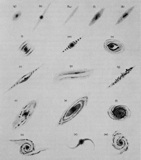
A better approach is to choose categories which themselves form a
coherent system
An ideal classification system of this type would have the following :
- Classes bring order to diversity of galaxy forms
- Span/include majority of galaxies
- Unambiguous & easily identified criteria
- Relate to important physical properties
 provide insight into internal processes, formation, & evolution
provide insight into internal processes, formation, & evolution



(2) Caveats with Standard System
- Based on limited sample of galaxies (selection effects).
Nearby bright field galaxies of high(ish) surface brightness.
- Based on photographic images in the blue
- emphasises star formation (not mass distribution)
- appearance can vary greatly with waveband.
E.g. care classifying with R or I images;
difficult comparing galaxies at high-z since rest UV can look very different.
 eg examples of UV vs Optical comparisons :
[image]
eg examples of UV vs Optical comparisons :
[image]
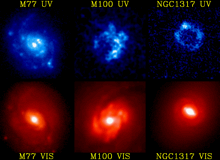
- Requires reasonably good spatial resolution across the galaxy (~20 elements)
(progressively more difficult for cz > ~8,000 km/s from ground).
- Many kinds of galaxies don't fit easily into the standard Hubble scheme:
- Disturbed or interacting galaxies
- Galaxies at high-z (eg ~30% @ z~1 don't fit :- "peculiar")
- Low Surface Brightness (LSB) galaxies



(3) Brief History of Hubble Sequence
Fairly detailed histories are given in :
Sandage's article in Stars and Stellar Systems
Vol. IX (1975) [o-link]
de Vaucouleurs' article in Handbuch der Physik, Vol 53 (1959)
[o-link]
- 1926 : Hubble introduces simple tuning fork (ApJ 64 321).
(after, of course, he establishes that spiral nebulae are extragalactic in 1924).
- 1936 : Hubble adds S0 & SB0 (Realm of the Nebulae).

Hubble's original tuning fork diagram: [image]
(a) Revisions by Sandage :
- 1961 : Hubble Atlas published (introduction describes classification system).
- 1975 :
(Stars and Stellar Systems vol IX) Sandage extends and
includes features introduced by deVaucouleurs and also van den Bergh
- 1981 : Revised Shapley-Ames Catalog published (1246 galaxies classified
by Sandage and Tammann).
- 1992 : Carnegie Atlas published (Sandage & Bedke, 1168 images); introduction
describes system.
Similar to Sandage 1975, adding some other (more idiosyncratic) features.
(b) Revisions by deVaucouleurs :
- 1959:
Handbuch der Physik 53 275, excellent article with examples:
[o-link]
A more modern collection of CCD images is given here: [o-link]
- The system explicitly introduces continuity along three axes:
stage, (early-late); family (bar); variety (inner ring) [see below]
- The deVaucouleurs system is used in the Reference Catalogue of Bright
Galaxies :
RC1 (1964), RC2 (1976), and RC3 (1991) containing 2600, 4364, and
23,024 galaxies



(4) Description and Illustration of Types
(a) Overview:
- Four Basic Components : Spheroid; disk; bar;
arms.
Presence/absence & relative strength of these components defines class
Sketch of modern Hubble tuning fork (from Buta, EAA) :
Real examples, including edge-on examples: [image].
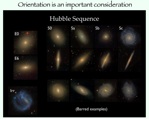
- For historical reasons the terms Early (left) to
Late (right) are used
This is because Hubble was impressed by Jean's theory of galaxy formation.
We do NOT now consider this a simple evolutionary sequence.
(b) Ellipticals : E
(c) Lenticulars : S0
- Like ellipticals, S0s have smooth structureless light distributions
[image]
- Central concentration (bulge) + envelope (disk) of less steep gradient
- Can sometimes have a bar: SB0
- deVaucouleurs subdivides early types:
E+, S0-, S0o, S0+, S0/a
- Difficult to classify (unless edge on), easy to confuse with Ellipticals
S0s have a flatter light distribution than Es
In uncertain cases, the designation E/S0 is commonly used
(d) Spirals
- Comprise: Bulge + (bar) + (ring) + disk + arms

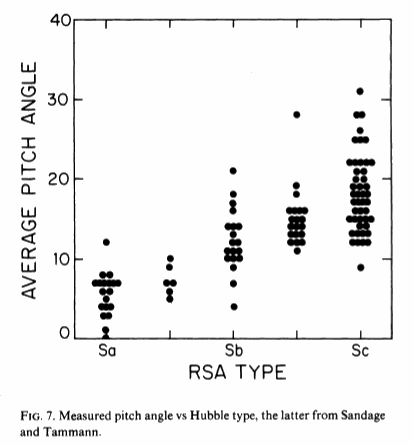
- Stage
- a,b,c,d,m, with intermediates (eg Sab, Sdm) defined principally by
[image]
- Bulge/disk (B/D) ratio
- Pitch angle (
 ): e.g. "tightly wound," or "open"
): e.g. "tightly wound," or "open"
- Resolution of arms into HII regions
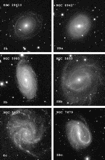 Examples (with unbarred down LHS): [image]
Examples (with unbarred down LHS): [image]
- Sandage emphasises
 over B/D ratio (eg Hubble atlas
explicitly ignores B/D)
over B/D ratio (eg Hubble atlas
explicitly ignores B/D)
deVaucouleurs emphasises B/D ratio over 
Since B/D and  don't correlate perfectly, Sandage
and deVaucouleur types
don't correlate perfectly, Sandage
and deVaucouleur types
can sometimes differ (e.g. RSA and RC3 types may differ)
- Edge-on systems have postfix (sp) for "spindle" (and stage estimated from
B/D ratio)
- deVaucouleurs introduces T integer (-5 to +10) which tracks
the stage (E to Im)
| Type | E | E+ | S0- |
S0o | S0+ | S0/a | Sa |
Sab | Sb | Sbc | Sc |
Scd | Sd | Sdm | Sm |
Im |
| T | -5 | -4 | -3 |
-2 | -1 | 0 | 1 |
2 | 3 | 4 | 5 |
6 | 7 | 8 | 9 |
10 |
- Bars

- Linear feature of stars: examples (with barred down RHS): [image]
If bar present then arms usually start at end of bar
- deVaucouleurs explicitly notes non-barred galaxies (SA)
and also introduces intermediate bars (SAB) : eg SAcd, SABa, SBb
- Sandage keeps original Hubble notation, eg Scd SBb
He has no intermediates
- Rings
- Nuclear rings, usually associated with star formation (not coded)
- Outer ring: prefix R; outer pseudo-ring : prefix (R)
- Inner ring: (s), (rs), (r): no, weak, strong inner ring
- If inner ring present then arms usually start from the ring
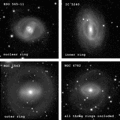
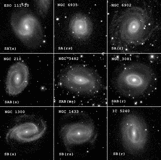
- Bars and inner rings are closely associated: both linked to resonances
Examples of all kinds of rings (Nuclear, Inner, Outer): [image]
Examples of all combinations of SA,SAB,SB with (s),(rs),(r) : [image]
- The deVaucouleurs System:

- Is really a 3-D classification system, illustrated here:
[image]
- Here's the whole system laid out as a [table]
- One virtue of this system : you can omit what is not possible to discern
 e.g. SB(r)cd ..... SBcd ..... Scd ..... S... for progressive loss of detail.
e.g. SB(r)cd ..... SBcd ..... Scd ..... S... for progressive loss of detail.
(e) Very Late Spirals and Irregulars
(f) Peculiars
5%-10% galaxies are classified as "peculiar"
These don't fit easily into E, S0, S, I or dwarf categories
Nor are they mildly unusual, with postfix "pec", which is common
(e.g. M87 is E0pec)

Catalogues : Vorontsov-Vel'yaminov (1956) and Arp (1963)
[o-link].
Most are the result of interactions
[images] (see Topic 13)
Induced star formation (and associated dust) leads to a large spread in color.
Examples of Amorphous Irregular; Polar Ring; Interacting Pair; and Merger.




(5) Relative Frequency of Types
A detailed discussion requires analysis of catalogue selection effects:
e.g.
Flux-limited sample will under-represent Sd Sm Im dE dSph
because of their low luminosity.
Here we simply take a cursory census of the RSA catalog.
Broken down by stage and bar, we have
| Ordinary | Barred |
| E+E/S0 | 173 | ... | ... |
| S0+S0/a | 142 | SB0+SB0/SBa | 48 |
| Sa+Sab | 123 | SBa+SBab | 42 |
| Sb+Sbc | 187 | SBb+SBbc | 96 |
| Sc | 293 | SBc | 77 |
| Scd+Sd | 26 | SBcd+SBd | 8 |
| Sm+Im | 13 | SBm+IBm | 9 |
| S | 16 | ... | ... |
| Special | 18 | ... | ... |
| Totals | 991 | ... | 285 |
- Roughly equal numbers of each Hubble type, from S0 to Sc.
- Significantly fewer late type galaxies (Scd to Im), because lower luminosity.
- Roughly constant fraction of ~25% Barred galaxies along the sequence
- ~50% Sa-Sc galaxies have some kind of inner ring



(6) Other Classification Systems/Extensions
(a) DDO (van den Bergh 1960) "Luminosity Classes"
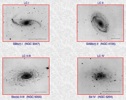
- Although called "Luminosity Class" this is really a classification of arm definition
(Later work showed arm definition and luminosity only weakly correlated).
See RSA for pictures illustrating the luminosity classes :
[o-link]
Classes I,II,III,IV,V (with intermediates)
[examples]
(b) Elmegreen & Elmegreen (1982, 1987) Arm Classes

- Similar to DDO luminosity classes
AC 1 = Flocculent: chaotic, fragmented, unsymmetrical arms:
[image]
.... etc ....
Intermediate : "Multiple Arm" -- strong inner arms, outer ratty appearance
.... etc ....

AC 12 = Grand Design: two long strong spiral arms dominating the disk:
[image]
- Grand Design spirals are 32% isolated galaxies and 67% binary galaxies, suggesting:
Grand Design are related to m=2 density wave, while
Flocculent may not be, but probably arise from local disk instabilities
(see Topics:
5.6
6.4
6.5)
(c) van den Bergh's "Trifork" Diagram
van den Bergh (1976) introduces disk gas/arm prominence as secondary parameter



(7) Automated Galaxy Classification
Modern CCD imaging surveys generate vast numbers of galaxy images
There is a need for fast, objective, robust classification.
Several approaches:
(a) Brute Force Approach
Members of the public learn simple classification and classify SDSS galaxy images.
In first year: 150,000 people made 50 million classifications!
Cross-comparisons self-calibrate and reduce "noise".
Second phase: more detailed classification of SDSS galaxies in "stripe-82" & HST images
Data successfully used for a number of projects.
(ii) Neural Nets
Images of a sample of well-classified galaxies are analyzed using many parameters.
Computer uses "Neural Net Algorithms" to find associations between classes and parameters.
Basically, it "learns" how to classify, and so can then classify other images.
Ultimately, about as good as people, as long as galaxies conform to classification scheme. (ref)
(b) Automated Approach
Often, surveys yield distant galaxy images that are too small for detailed classification
But it is still crucial to know basically what type of galaxy they are.
A number of simple parameters have been found to be very useful:
(i) Simple Image Parameters
After some experimentation, it seems a good system uses three (CAS) parameters: concentration, asymmetry and smoothness. Modern CCD surveys also yield reliable color information, so this is also used.
- Concentration: tends to track the stage (elliptical
 spiral) since it correlates with bulge/disk ratio, and bulges are denser than disks.
spiral) since it correlates with bulge/disk ratio, and bulges are denser than disks.
There are several parameters that track concentration:
- R90/R50 where R90, R50 are the radii enclosing 90% & 50% of the flux.
- Sersic n: fit Sersic profile, I(R) = Ie exp(-b [ (R/Re)1/n - 1 ] )
Re = effective (half-light) radius; Ie = surface brightness at Re
Solve for n: e.g. n = 1 (exponential), n = 4 (deVaucouleurs) [examples]
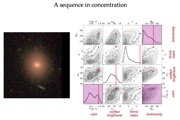
-
 2 goodness of fit: to model brightness profiles
2 goodness of fit: to model brightness profiles
e.g. try deVaucouleurs; exponential; or PSF fits, and see what the  2 value is.
2 value is.
- Asymmetry: This correlates well with distortions and interactions
One can cast an image as odd + even functions, the odd functions give the asymmetry
Another approach subtracts a reflected version and looks at the residual.
- Smoothness: This traces star formation rates, or multiple components in a merging system.
This can be estimated several ways (e.g. M20 and GINI parameters):
e.g. comparing 2nd moments of the entire image, and the brightest 20% of the pixels
- Color: This tracks the mean age of the stellar population in the galaxy.
This turns out to be usefully different from the stage (elliptical/spiral) parameters.
(ii) Example Results from SDSS
The Sloan Digital Sky Survey (SDSS) provides image parameters (and images) for a million galaxies.
Although explicit Hubble types are not given, several parameters effectively trace this
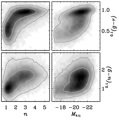
Some examples are shown here: [image]
These tend to show two primary classes of galaxy
On a galaxy color-magnitude plot they appear as "blue and red sequences"
[image]
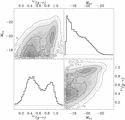
- younger population (blue star forming) spiral disks
- older population ("red" "dead) elliptical-like bulge dominated galaxies



(8) Physical Morphology
- Classical morphology focusses only on apparent form
It is usually a mistake to include theoretical prejudice, particularly early on
As understanding builds, it becomes reasonable to use theory to inform classification
One can view classification as identifying groups of stars with different dynamics/histories.
Kormendy (1982, 12th Saas Fee) has emphasized this approach.

- Here is his description of the physical origin of the major classified components :
| Component | Formation Mechanism |
| Halo | Dissipationless collapse of ?? during early phase
of galaxy formation |
| Spheroidal : Elliptical | Dissipationless collapse + mergers;
(stars form before/during collapse) |
| Spheroidal : Bulge | Ditto above but less so |
| Disk : Thick | Ditto below but more so |
| Disk : Thin | Dissipational collapse;
(stars form after collapse) |
| Bar | Dynamical instability during collapse + secular growth |
| Lens | Made from bar by destruction of resonance |
| Inner ring (r) | Disk material rearranged by bar |
| Outer ring (R) | Disk material rearranged by bar |
- One can think of a galaxy as the sum of these components
their relative strength defines (in large part) the type class
- Implicit in this table is evolution : both initial and secular
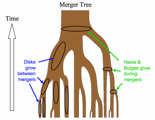
birth process important in defining bulge/disk
ongoing interactions/resonances can generate bars/lenses/rings






 classify them
classify them



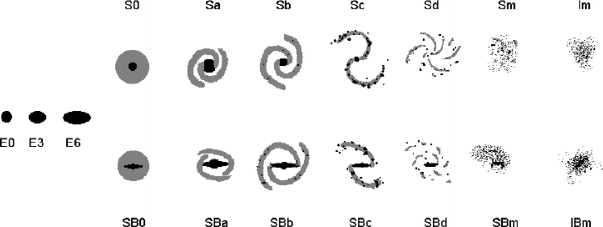

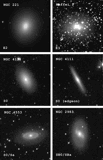 Examples of Ellipticals and S0 galaxies:
[image]
Examples of Ellipticals and S0 galaxies:
[image]
 r1/n n = 2 - 10 (n = 4 is the de Vaucouleur's profile)
r1/n n = 2 - 10 (n = 4 is the de Vaucouleur's profile)
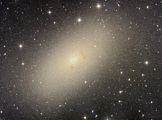
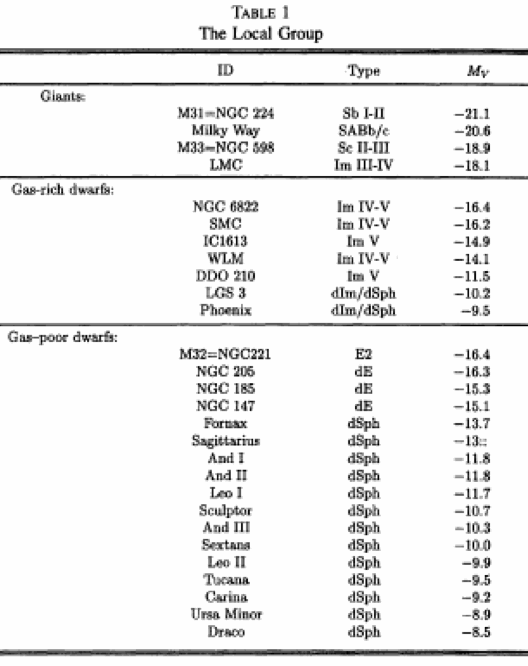
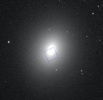


 ): e.g. "tightly wound," or "open"
): e.g. "tightly wound," or "open"







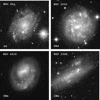

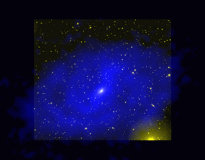









 2 goodness of fit: to model brightness profiles
2 goodness of fit: to model brightness profiles


